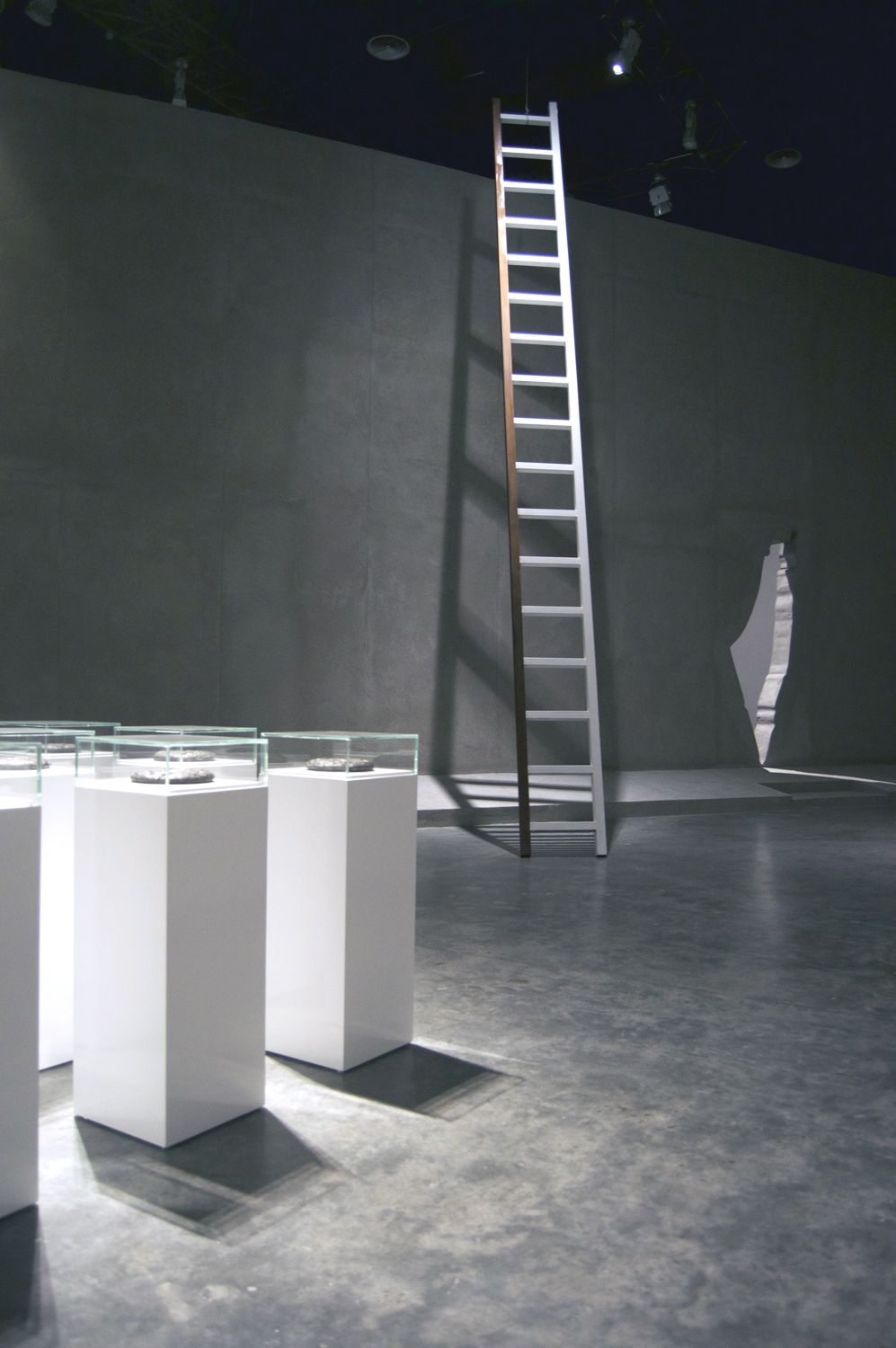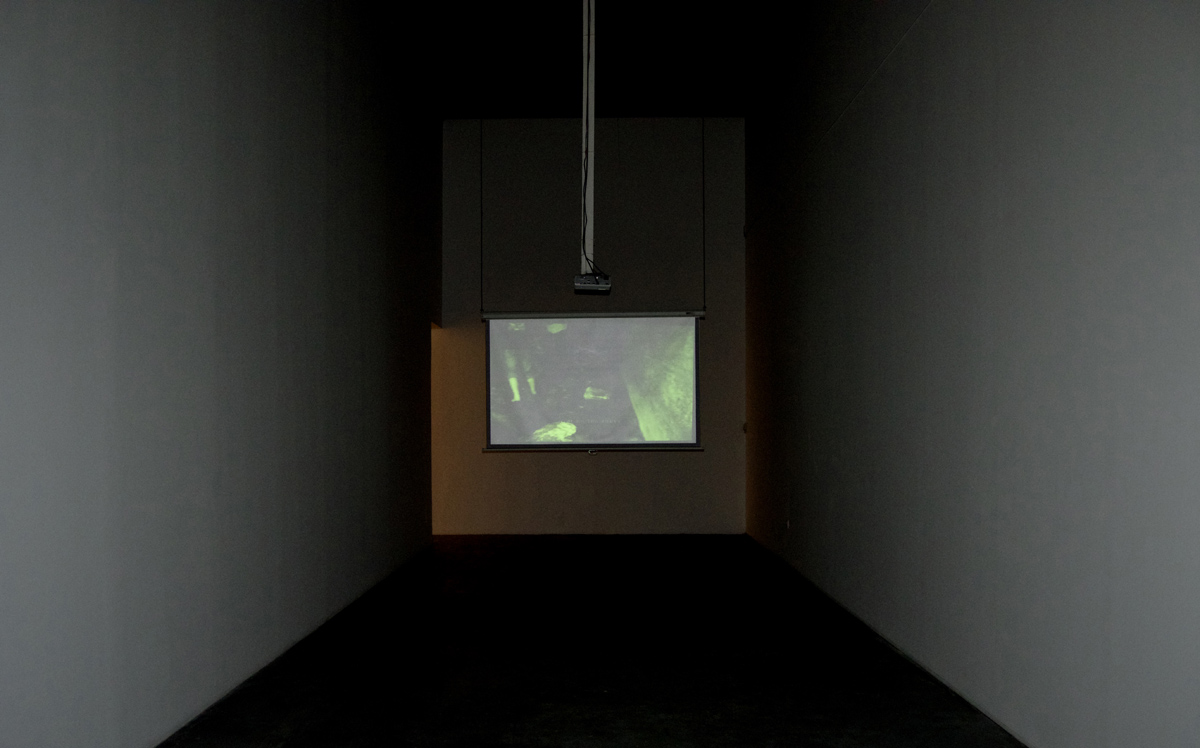Shows
“Castles Built from Sand Will Fall”


“Castles Built from Sand will Fall” was Ayyam Gallery’s last show of 2016, and it was a fitting end to a year filled with political upheaval and societal temblor. Palestinian artist Khaled Jarrar’s title for the exhibition addresses the instability of man-made boundaries between people, and the constant reshuffling of acceptance and rejection in society. Jarrar has made the transition from enforcing sovereign territorial borders to committing to tear them down. He was militarily trained as a bodyguard in the Palestinian Presidential Guard when Yasser Arafat presided over the Palestinian National Authority. In 2002, he was injured during a raid on Arafat’s headquarters by the Israel Defense Forces, which sparked a period of self-reflection. Soon after, his artistic practice emerged.
For this exhibition, Jarrar divided the vast gallery with a diagonal wall that ran through space. The tall structure produced a shadow that shrouded the room in dim light with an overwhelming feeling created by the omnipresent grey partition. This barrier served as a backdrop for Khaled’s Ladder (2016), a replica of a public art piece created during his February trip to the United States with art group, Culturunners. At that time, the US Presidential race was in its early stages, escalating anti-immigrant dialogue. Donald J. Trump first mentioned plans to tighten deportation policy and build a wall along the US-Mexico border in June 2015; both of these talking points became cornerstones of his presidential campaign, and still fuel an increasingly open display of racial discrimination. The infamous international border wall extends past the shoreline and into the Pacific Ocean, demonstrating the depth of fear and learned xenophobia in parts of both countries’ populations. On his trip, Jarrar visited this border in a journey documented in an eight-minute video of the same title that was included on the other side of his wall in Ayyam Gallery. During his time at the US-Mexico divide, he detached a small portion of the metal barrier, which was used to create a monument that would bring people together, not force them apart. Consistent with his practice—deconstructing small portions of the wall that sits in close proximity to his current residence of Ramallah in Palestine—he upcycled and reconstituted this collected metal pylon to fashion a message of hope. The version of Khaled’s Ladder presented in the exhibition a replica, positioned at a slant, its tip several feet away from the wall but not leaning against it, giving the impression of an unstable placement. The gap signifies that humanity is close to bridging the divide but there is something holding us back; we may still have a long way to go before boundaries dissolve and humanity’s tensions subside.

The wall in the gallery had an opening that the audience was encouraged to walk through to access four of Jarrar’s videos and the namesake piece for the show, Castles Built from Sand will Fall (2016). The Styrofoam tablet stands over two meters in height, and bears its title in capital letters. To create this sculpture, the artist also employed upcycling by combining reconstituted cement from the wall that surrounds the West Bank into the panel’s coating. The block letters served as a stark reminder of the nature of borders—they are dictated according to fluctuating, insubstantial motivations. Divisions based on hatred are taught, not innate. When people power is harnessed, we can shatter those partitions, and maybe even build a better world.
The smaller room in the exhibition space plunged the viewer into darkness to simulate tunnels and holes made to connect people in Israel and Palestine who are separated by the so-called security barrier. Ka’ak Al Quds (2016) is a knee-height video installation with a screen set in a Styrofoam panel similar to Castles Built from Sand will Fall. A young boy is depicted passing the Ka’ak al-Quds, or Jerusalem bread, through a small hole. Barriers may limit movement, but humanity will always find a way to bypass the division.


To the left of the installation, at the end of the narrow room, was Journey 110 (2008). Its first two minutes make the piece easy to miss; the dark screen seamlessly blends into the void, but a murmur of voices primes us. The faint sound of water sloshing below footsteps is heard, offering context. As the video proceeds, the audience is made aware that they are following a group of people crossing a dark tunnel filled with black, sludgy water; their shoes are wrapped by plastic bags to prevent contamination. The passage is blocked, but they manage to climb upward through a small hole illuminated by bright sunlight. One is immediately reminded of the belief that death leads us toward light, or the popular phrase of optimistic outlook that there is always light at the end of the tunnel.
“Castles Built from Sand will Fall" exposed divisions created for political gain and criticizes attempts to restrict people with the aim of enhancing governmental control. Some references may appear straightforward, but Jarrar’s methodology is engaging and inclusive, and his conceptual ideas are carefully thought through. When the exhibition closed after the first week of January, the show created a sense of optimism for a new year with the notion that we can infiltrate the gaps between barricades placed between us by the powers that be. Jarrar successfully uncovers and broadcasts stories of those living in the shade of these unnatural divisions and illustrates that it is a global tragedy.
“Castles Built from Sand will Fall” was on view at Ayyam Gallery, Dubai, until January 7, 2016.







